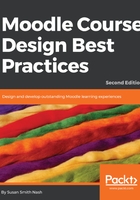
Cognitive psychology as applied to learning
For those who are interested in what is going on beneath the surface, let's take a moment to review the cognitive processes involved in learning. As we design a course, we should consider how the mind makes meaning, how knowledge occurs, and what the ideal conditions are for creating an optimal environment for learning.
Cognitive psychology is the category of social sciences that covers the learning process, and it perfectly encompasses the processes we must understand to design an excellent course.
To maintain a clear focus, we will begin and end with learning objectives (also referred to as outcomes). The learning objectives encompass the cognitive psychology processes and fields in learning. Now, how do we write good learning objectives? Because you are focusing on student performance and bearing in mind what you'd like your students to do and how they should be able to demonstrate their new knowledge, skills, and abilities, your outcomes need to be written with a plan of action in mind.
So, we can apply these ideas from the very beginning as we develop a course in Moodle. We have the learning outcomes. Now Moodle gives us the opportunity to structure the course so that each unit ties to a topic. Each topic can directly link to a learning objective or a course outcome.
Here's an example from the Tourism Trends course. The first page has the overall learning objectives and, then, as we create a structure for the course, each topic corresponds to a learning objective. Notice in the screenshot, that there are eight topics. If this is an eight-week course, each topic can correspond to one week. If it's a 16-week course, each one can correspond to two weeks.

So, as you go through the process of determining what the learning objectives should be for your course, jot them down. You may come up with a long list, but, later, make sure that you select the ones that best reflect what you'd like your students to achieve. We'd like to follow best practices for instructional design, so we recommend that your final list should contain not more than six or seven objectives.
You can learn more about best practices for developing learning and performance outcomes in the classic work The Systematic Design of Instruction by Walter Dick and Lou Cary in 1978. Their work was so influential that it came to be known as the Dick and Carey Systems Approach Model and was widely adopted by instructional designers and training developers. For an overview of the Dick and Carey Systems Approach Model, you may visit the Big Dog & Little Dog's Performance Juxtaposition page at http://www.nwlink.com/~donclark/history_isd/carey.html.
To transform your informal list of desired outcomes to formal learning outcomes statements, you may benefit from using the SMART approach, which was first developed by George T Doran in the November, 1981 issue of Management Review. Since it was first published, it has become very popular in many applications that need to measure goals and outcomes. The criteria are very handy for making sure that your statements are complete. In addition, they are very good for goal-setting and motivation. Here are the SMART guidelines, where your outcomes should be as follows:
- Specific: Make sure that the desired outcomes are not too broad
- Measurable: Include a quantity or a way to measure progress
- Attainable: Your desired outcomes need to be achievable
- Relevant: Make sure that the desired outcomes relate to your course
- Time bound: Make it clear by when the objective should be achieved
As you write your SMART outcomes, be sure to avoid verbs or phrases such as understand, appreciate, know about, familiarize yourself with, and develop an awareness of. Instead, use active verbs and phrases that connote measurable results, such as identify, describe, analyze, evaluate, and create. Look back at the guidelines for writing learning outcomes, and you'll see that some of your original outcomes may not be measurable and may also have other deficiencies. Once you recognize that, be sure to change them as soon as you can. This will allow you to create a map that ties the learning outcomes to your resources, activities, and assessments.